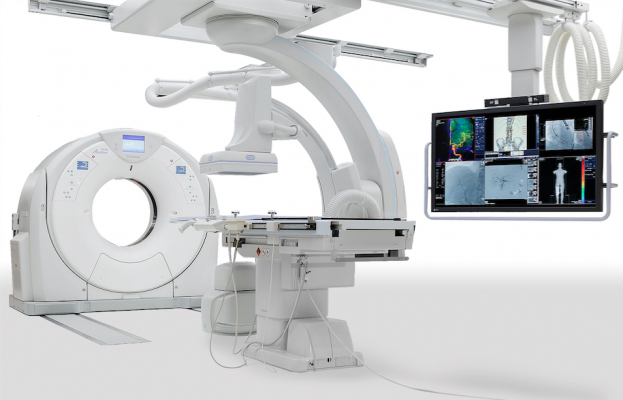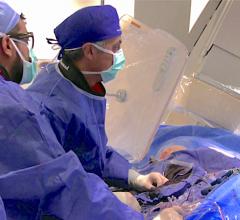
Toshiba’s Infinix 4DCT combines an Infinix Elite angiography system an Aquilion One Vision edition CT system. It allows clinicians to plan, treat and verify in a single clinical setting. The CT system is capable of capturing an entire organ in one rotation with 640 slices and 16 cm of anatomical coverage.
Angiographic imaging system vendors have developed new technologies to address emerging cath lab trends, including the need to reduce radiation dose, improve image quality and enable advanced procedural image guidance. All three of these points have become increasingly important as more complex procedures are attempted in interventional cath labs and hybrid ORs. These procedures include transcatheter aortic valve replacement (TAVR), MitraClip repairs, left atrial appendage (LAA) occlusion, atrial and ventricular septal defect closure, and new interventions for electrophysiology (EP) and heart failure.
Advanced Imaging, Guidance, Planning
Newer angiography imaging systems enable advanced 3-D imaging with rotational angiography, which uses a quick spin around the patient to create a computed tomography (CT)-like, 3-D image of the anatomy. This can all be done tableside in the cath lab. Some systems allow these images, or CT or magnetic resonance imaging (MRI) 3-D images, to be overlaid or fused with the live 2-D fluoroscopic images. This fusion technology is used with TAVR planning and navigation software to better guide device placement. Software also allows 3-D images to be integrated with EP electromapping systems to guide catheter ablation procedures without the need for live fluoro, helping reduce dose.
At the Radiological Society of North America (RSNA) 2014 meeting, Siemens introduced its Artis With Pure technology, which simplifies the use of 3-D rotational angiography. The software suggests protocols for ease of use and offers step-by-step instructions to fuse the image.
Siemens’ Syngo Dyna 4-D imaging now enables a combined digital subtraction angiography (DSA) and DynaCT (a CT-like 3-D image) at the same time to show filling of vessels with contrast. The Syngo DynaCT SMART feature can remove metal streak artifacts tableside from 3-D reconstructions. A Quick Zoom feature also allows zooming in on a region of interest tableside without the need to manually manipulate images in the control room. The technology can be retrofitted on older Artis systems.
New software suites for various specialties have been introduced for Philips’ angiography systems, including interventional oncology, interventional neurology and for the hybrid OR suite. The oncology suite can perform two passes with the C-arm to collect images of the arterial and tumor phases with contrast to combine them into a single image to help guide embolizations. The software also features automated feeder vessel detection. Philips EchoNavigator software enables fusion with live 3-D/4-D transesophageal echo (TEE), showing the relation of the TEE image on live fluoro.
At RSNA 2015, GE showcased its Assist brand, a collection of new interventional imaging software packages designed for specific clinical subspecialists. The suite offers simple-to-use fusion imaging for -CT 3-D image reconstructions that can be overlaid or fused with live angiography in the cath lab. The new Assist suite of targeted software solutions include Vessel Assist to better navigate vessels for chronic total occlusions (CTO), transjugular intrahepatic portosystemic shunt (TIPS) and interventional neuroradiology arteriovenous malformation (AVM) and aneurysms. The EVAR Assist aids endovascular aortic repair (EVAR). Needle Assist is for bone interventions and pelvic bone osteosynthesis. FlightPlan for Liver helps with liver embolizations. Valve Assist is for transcatheter aortic valve replacement (TAVR). PCI Assist helps navigate complex percutaneous coronary intervention.
At the 2015 American College of Cardiology (ACC) meeting, Toshiba highlighted its 3-D rotational angiography capabilities and its new transcatheter valve planning and image fusion capabilities. The 3mensio Structural Heart software facilitates pre-operative planning of aortic andmitral valve procedures, and LAA closures. It can also fuse 3-D CT or MRI images with live fluoroscopy to enable procedural guidance.
Radiation Reduction
All the new angiography systems on the U.S. market offer dose-lowering technologies. These advances include improved X-ray tubes, more sensitive detectors and software to help improve image quality at lower doses, in addition to noise reduction. The Philips Allura Clarity is an example of the next-generation system that can help lower standard procedural dose by 50 to 75 percent. The operator can adjust the frame rates to reduce dose, and the system incorporates Philips’ ClarityIQ software to achieve excellent visibility at low X-ray dose levels for patients of all sizes. The software helps correct for motion, reduces noise, auto enhances the image and corrects pixel shift on cine images.
Toshiba’s Spot Fluoroscopy software for its Infinix-i systems allows clinicians to observe a target region of anatomy using Spot Fluoro’s live fluoroscopy, while viewing the last image hold (LIH) in the surrounding area that has been collimated out of the field of view to cut dose.
GE, Toshiba and Philips offer software to visualize the dose accumulation (peak skin dose) on a patient in real time to serve as a reminder to move the C-arm to avoid burns.
Read the article "Real Time Monitoring of Staff Dose in the Cath Lab"
Newer Systems
Siemens introduced several new systems in its Artis series, including the Artis Q, Artis Q.zen and the Artis one. These incorporate both new X-ray tubes and detectors to lower dose and cut energy consumption by up to 20 percent. Siemens’ new X-ray tube uses flat emitter technology, which enables smaller, square focal spots that the vendor said leads to as much as 70 percent improved visibility of small vessels and improved image quality. The Artis Q.zen combines this X-ray tube with a new crystalline detector that enables patient doses as low as half the standard angiography levels.
The Artis Q, Artis Q.zen and Artis one include the Clearstent Live application, which freezes motion in the region of a stent, allowing the physician to mask out movement of the beating heart and place the stent in precisely. The Artis one also offers new tools for cardiac imaging, including HeartSweep, which uses dual-axis rotational angiography to image the entire heart in a single, smooth C-arm movement instead of multiple acquisitions from different projections.
At RSNA 2014, Toshiba introduced its new line of combination CT/angiography systems. It combines an Infinix Elite angiography system with an Aquilion Prime or Aquilion One Vision Edition CT system. This offers an all-in-one interventional lab and CT solution to deliver real-time CT images during procedures instead of CT-like rotational angiography images. It can significantly improve workflow with its SURE Guidance technology, allowing image transition between modalities. At RSNA 2015, Toshiba showcased its Infinix 4DCT, which merges the Infinix Elite angiography system and Aquilion One Vision edition CT system. The Aquilion One Vision is capable of capturing an entire organ in one rotation with 640 slices and 16 cm of anatomical coverage. The combination of the interventional lab and CT eliminates the need to transfer patients between departments and allows clinicians to decrease procedure time and maintain patient safety.
Shimadzu’s new angiography system platform is the Trinias series. It uses high-speed Score Pro image processing technology, and a smart ergonomic design aids intuitive functionality. Score Pro enhances fluoroscopic images while maintaining as low as achievable dose considerations.
Designed as an angiographic interventional system, Trinias offers a new 12-inch Crossover flat panel detector for multi-procedure versatility that accommodates any type of angiography procedure. Combined with Score Pro image processing, the systems provide excellent visibility and numerous image guidance functions, as well as sophisticated 3-D application techniques. When used as a cardiac or neuro interventional system, Trinias is equipped with a new 8-inch flat panel detector. The system also has StentView, which improves visibility of existing stents in vessels.
GE Healthcare introduced its Discovery IGS series in 2013. The laser-guided system captures the advantages of floor- and ceiling-mounted fixed systems and the mobility advantage of mobile C-arms without any of their inherent limitations. The imaging device is on a mobile, wheeled gantry that can be moved anywhere in the room like a mobile C-arm, but offers precision, high-quality imaging and features of a fixed system.
Angiography Imaging Systems Comparison Chart
This article served as an introduction for the DAIC comparison chart on angiography systems. The chart includes all the players on the U.S. market and offers an apples-to-apples comparison of technical specifications. The chart requires a login, which is free and only takes a minute to sign up. It can be accessed at www.dicardiology.com/content/angiography-systems.


 January 31, 2024
January 31, 2024 






